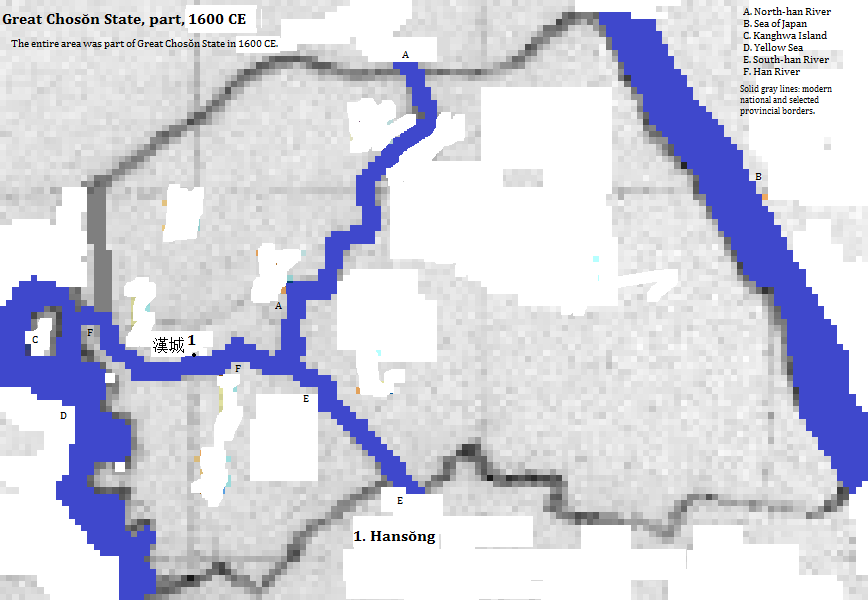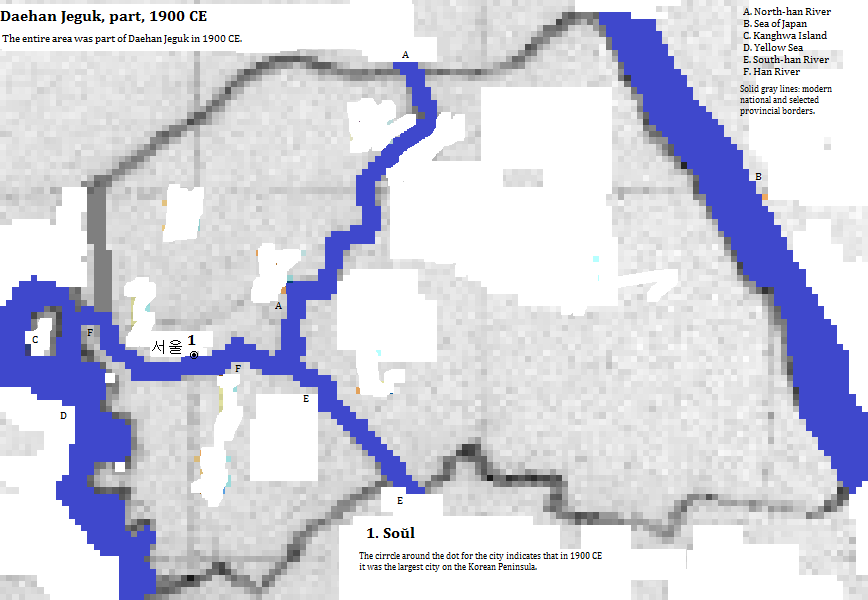
| To Duval Family Home Page | Asia | 조선 and 대한 Chosŏn or North Korea and Daehan or South Korea |
| To Chris Home Page | To Earth (Geography Home Page) |
서울 (Sŏul, also transliterated as Seoul), is the capital of 대한 (Daehan or South Korea) and the center of a metropolitan area of 21.6 million
In 서울 (Sŏul) itself, Three IFC Office Tower (2012) is 55 stories but 915 feet high, taller than the 73 story, 865 foot, Tower G (2004) of the skyscraper complex, Tower Palace Three. The most famous office building is the KLI 63 Building, 817 feet tall and 60 stories, the city's tallest building until surpassed by Mok-dong Hyperion I, Tower A (completed 2003). Also in the city is (as of 2015) Asia's largest football (soccer) venue: the Sŏul World Cup Stadium (2001).
UNESCO honors as a World Heritage Site numerous tombs from the Chosŏn (Jeoson) Dynasty, most of which are in the metropolitan area.
Tourists enjoy the Korean Folk Village in 용인 (Yongin), a city of 899 thousand.
The city gained prominence as capital of the Great Chosŏn State, first under the name 漢陽 (Hanyang), shortly after (by 1500) as 漢城 (Hansŏng or Hanseong), and grew (despite all the urban destruction) during the Korean War as refugees poured into the area, and added yet more millions since.
| Year | Population | Political entity |
| 1400 CE | 100,000 | Great Chosŏn State |
| 1500 CE | 125,000 | Great Chosŏn State |
| 1700 CE | 158,000 | tributary to Zhongguo/ Dulimbai Gurun (to the Empire of China) |
| 1800 CE | 194,000 | tributary to Zhongguo/ Dulimbai Gurun (to the Empire of China) |
| 1900 CE | 195,000 | Daehan Jeguk (Korean Empire) |
| 2012 CE | 21,600,000 | 대한 (Daehan or South Korea) |
UNESCO honors the Changdeokgung Palace Complex as a World Heritage Site, whose 15th century architectural, garden and landscape principles exerted influence of the subsequent centuries. Also honored is Jongmyo Shrine, which honors, in the Confucian manner, royal ancestors. It dates in its present form from the 16th century.
Tourists enjoy the Gyeongbokgung Palace and the Namdaemun Market.
인천 (Inch'ŏn) is located at the mouth of the Han and has a population of 2.8 million.
수원 (Suwon) is south of 서울 (Sŏul). The tallest conventional building is the 522 foot (48 story) Gwanggyo Prugio Worldmark 1 (2015), used for residences, while an observatory, the Hwaseong Observation Tower (2002), is, at 656 feet, taller.
The international airport of 김포 (Kimp'o or Gimpo), a city of 261 thousand
Changdeokgung Palace buildings and grounds, Sŏul, Daehan






1. 2012 figure from world-gazetteer.com, accessed 2/6/2013. It is the fifth largest metropolis in the world, and the largest in the Korean Peninsula.
2. 2012 figure from https://en.wikipedia.org/wiki/List_of_cities_in_South_Korea, accessed 12/2/2015.
3. Emporis.com, accessed 12/2/2015.
4. UNESCO, World Heritage Sites (Firefly Books, 2010). The tomb sites are: the Donggureung Tomb Cluster in 구리 (Kuri or Guri); Gwangneung, Hangheung, Yureung and Sareung in 남양주 (Namyangju or South-Yangju); Jangneung in 김포 (Kimp'o or Gimpo); Jangneung and the Samneung Cluster in 파주 (P'aju or Paju); Heilleung, Illeung, Jeongneung, Seolleung, Taereung, Gangneung and Uireung in 서울 (Sŏul) itself; Olleung in 양주 (Yangju); the Seosamneung and Seosamneung clusters in 고양 (Koyang or Goyang); Yeongneung (King Hyojong) and Yeongneung (King Sejong) in 여주 (Yŏju or Yeoju); and Yungneung and Geolleung in 화성 (Hwasŏng or Hwaseong). According to https://en.wikipedia.org/wiki/List_of_cities_in_South_Korea, accessed 8/31/2015, populations as of 2012 for the cities not previously mentioned are: 구리 (Kuri or Guri), 195 thousand; 남양주 (Namyangju or South-Yangju), 580 thousand; 파주 (P'aju or Paju), 383 thousand; 양주 (Yangju), 200 thousand; 고양 (Koyang or Goyang), 961 thousand; 여주 (Yŏju or Yeoju), 109 thousand; and 화성 (Hwasŏng or Hwaseong), 518 thousand.
5. https://en.wikipedia.org/wiki/Seoul, accessed 12/2/2015.
6. Estimate in Tables of the World's Largest Cities, in Tertius Chandler, Four Thousand Years of Urban Growth, 2nd ed. (The Edwin Mellen Press, 1987). It was the largest city in the Korean peninsula in 1400, 1500, 1700, 1800 and 1900. Chandler does not cite a Korean city in his list for 1600.
7. They also look out on the Demilitarized Zone from spots within the metropolitan area. http://theplacesmusttravel.blogspot.com/2011/04/10-most-popular-tourist-attractions-in.html, accessed 8/31/2015.
8. https://en.wikipedia.org/wiki/List_of_the_busiest_airports_in_South_Korea, accessed 8/31/2015.